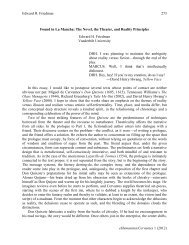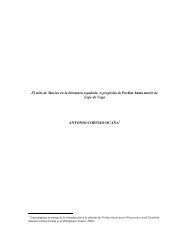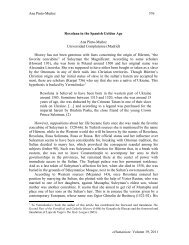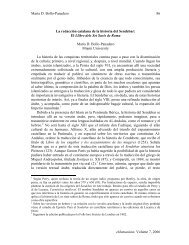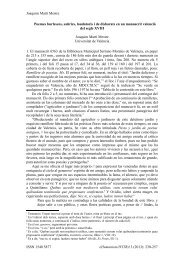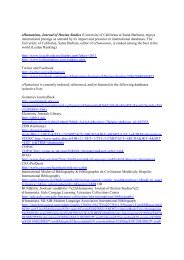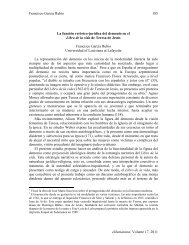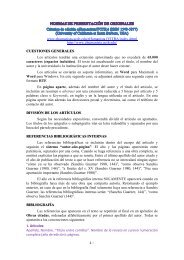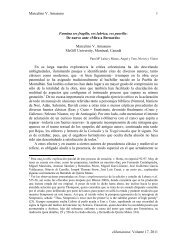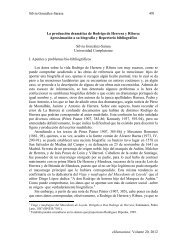Gregory Peter Andrachuk eHumanista: Volume 17, 2011 540 Alonso ...
Gregory Peter Andrachuk eHumanista: Volume 17, 2011 540 Alonso ...
Gregory Peter Andrachuk eHumanista: Volume 17, 2011 540 Alonso ...
Create successful ePaper yourself
Turn your PDF publications into a flip-book with our unique Google optimized e-Paper software.
<strong>Gregory</strong> <strong>Peter</strong> <strong>Andrachuk</strong><br />
without deeper significance but I believe that the accumulation of facts suggests<br />
otherwise. Let us add one other and very subtle point. In Vasquirán’s dream of the<br />
battle of Ravenna he sees a boat filled with the Spanish casualties; the first person he<br />
sees is integral to the narrative: it is his friend and rival in the debate, Flamiano<br />
(Jerónimo de Fenollet): “Conocí que en la proa de la barca venía Flamiano con<br />
muchas heridas en el rostro y en la persona” (183). But if we accept that the placement<br />
of certain names in the text has particular significance, 10 then the next person<br />
mentioned may be important: “Vi junto con él, a su costado, el conde d’Auertino, de la<br />
misma manera d’él herido” (183). We note two things here: first, immediately after the<br />
mention of Flamiano, co-protagonist of the work, the author has placed a member of<br />
the Cardona family, Juan de Cardona (“junto con él”) –despite the fact that he could<br />
have chosen any one of the many characters of Qüestión de amor killed or badly<br />
injured at Ravenna. Second, he refers to Juan de Cardona in a way which draws<br />
attention to him by using the titular pseudonym “de Avertino” which is, strictly<br />
speaking, proper to the first part. The author has stated earlier that in this second part<br />
of the work he will refer to the characters by their real names and titles: “Agora<br />
mudaremos el estilo o forma de la obra. Esto será que agora todos los caualleros y<br />
damas, assí de título como los otros, nombraremos por sus propios nombres en las<br />
cosas acaescidas después de esta fiesta fasta la dolorosa batalla de Ravena, donde la<br />
mayor parte d’estos señores y caualleros fueron muertos o presos” (158, emphasis<br />
mine).<br />
Yet, contrary to this definitively stated procedure, he refers to Juan de Cardona by<br />
the title used in the fictive first part. The astute reader, having been told to expect to<br />
find the real title (“Conde d’Auellino”, which indeed had already been used in this<br />
second part [160 and 161]) would be alerted to this as yet another clue. Although it<br />
may be argued that the context is that of a dream (and therefore that it is fiction rather<br />
than reality, thus permitting the use of a fictitious rather than real name), the effect is<br />
that the careful reader, having paid attention to the accumulation of clues, is once<br />
again led to focus on a member of the Cardona family. 11<br />
To summarize to this point: we have in Qüestión de amor at least three significant<br />
male members of the Cardona family: 12 the Viceroy Ramón Folch de Cardona, the<br />
10 This point has been made with regard to other characters associated with Vasquirán: Carlerín,<br />
Carliano and Carliner as well as the Prior de Mariana (Pedro de Acuña, Prior of Messina), the Marqués<br />
de Villatonda (Giovanni Francesco d’Acquaviva d’Aragona, Marqués de Bitonto) and the Prior de<br />
Albano (Jerónimo Centelles, Prior of Rome). See <strong>Andrachuk</strong> 2006, xxii-xxvi.<br />
11 The second and third casualties mentioned are treated in the same way, referred to by their fictive<br />
rather than real titles: “el prior de Mariana y el prior d ‘Albano” (183); they too are characters closely<br />
associated with Vasquirán in the first part of the story. Each time Vasquirán appears involved in a<br />
mock-bellicose setting (the jousts, the hunt, the juego de cañas) he is found in the company of these two<br />
prelates.<br />
12 Vigier (91) counts both Antonio and Juan, like Pedro de Cardona, Conde de Golisano, as members of<br />
“la branche sicilienne de la famille” but we shall see that likely both are of Valencian origin. Juan,<br />
Conde de Avellino is descended from the Bellpuig lineage, as is Ramón Folch de Cardona, Viceroy of<br />
545<br />
<strong>eHumanista</strong>: <strong>Volume</strong> <strong>17</strong>, <strong>2011</strong>



